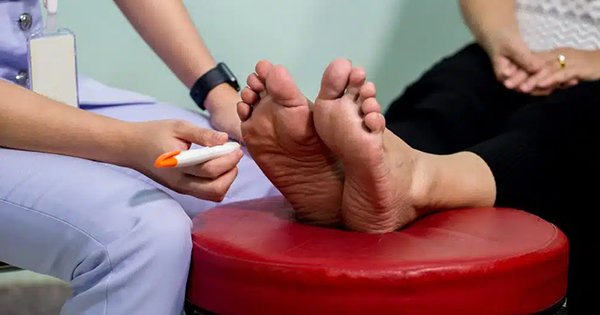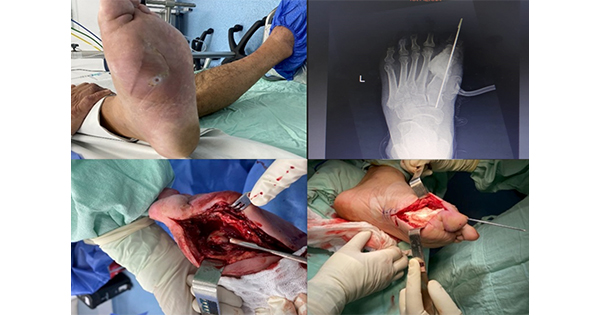Diabetes currently affects about 366 million people worldwide, with a projected rise to about 522 million by 2030 (International Diabetes Federation, 2011). The increasing prevalence of diabetes, together with its chronicity, has culminated in a rise in diabetes-associated complications (Dumville et al, 2011); one major complication being the development of foot ulcers (Nouvong et al, 2009). Consequently, diabetic foot ulcers (DFUs) have become a significant health problem in many parts of the world (Cavanagh et al, 2005) and it is a precursor to about 85% of lower-limb amputations.
Honey has been used in the management of infected wounds since ancient times (Jull et al, 2008), and reports on the healing properties of honey have long been documented (Al-Waili et al, 2011). Although the use of honey in wound healing waned with the discovery of antibiotics (Molan, 2002), there is now increased interest again in its applicability (Lay-flurrie, 2008). Extensive research has found the application of honey to be beneficial in the topical management of wounds of varied aetiologies (Cadogan, 2008; Eddy et al, 2008; Candeias and Cardoso, 2011; Evers, 2011).
Systematic approach to literature review
Although a number of reviews have been conducted into the use of honey for various types of wounds, no identified published review has evaluated the effects of honey on DFUs. The lack of research could suggest there have been no studies of the use of honey in the treatment of DFUs. A systematic approach to a literature review of honey as an alternative dressing agent in the management of DFUs would lead to an informed consideration of its potential role in clinical management and its place in the healthcare system. Research showing that honey can be used in this way would be beneficial as there is growing awareness that bacteria are resistant to antibiotics (Lay-flurrie, 2008) and there are likely to be increasing numbers of people with DFUs as a result of the increasing prevalence of diabetes (Majtan, 2010). The key aim of this literature review was to assess whether the use of honey as a topical wound dressing is beneficial in promoting the healing of DFUs.
Review method
An iterative process of identifying eligible studies was carried out by comprehensively searching electronic databases, such as The Cochrane Library, MEDLINE, CINAHL, AMED, INTERNURSE, Science Direct, Web of Knowledge, and PubMed. Google Scholar and the reference lists of potentially relevant studies and previous systematic reviews were also searched. A pre-piloted a priori inclusion and exclusion criteria related to the review question was used to determine the eligible studies for inclusion. Quality appraisal was undertaken primarily to assess the internal validity of the individual studies (Pope et al, 2007) using a modified critical appraisal tool.
The methodological quality of the included studies was assessed for the risk of bias on the basis of the following key quality items:
- Randomisation method.
- Allocation concealment.
- Use of blinding.
- Baseline comparability for prognostic factors, such as ulcer size and the presence of infection.
- Avoiding suggestion of selective outcome reporting – whether the study protocol is available and all pre-specified or expected outcomes of interest in the review have been reported in the pre-specified way (Bergin and Wraight, 2006).
Data from the included studies were extracted independently using a pre-piloted data extraction tool. The primary outcomes of interest were the time to ulcer healing, any change in ulcer size or grade, and the proportion of ulcers completely healed during study. The review also considered evidence of infection, and adverse events of treatment (reports of adverse occurrences of pain, irritation, or amputation following the use of honey).
Statistical pooling of data was inappropriate as the included studies all examined the use of honey in the treatment of ulcers in people with diabetes, however, they varied significantly in terms of the type of honey used, follow-up durations and experimental setting; consequently, statistical pooling of data across the studies was inappropriate. Therefore, the studies were categorised descriptively according to the primary and secondary outcomes of interest. Five published studies (n=289 participants in total) were eventually eligible to be considered in this review (Hammouri, 2004; Jeffery, 2008; Shukrimi et al, 2008; Makhdoom et al, 2009; Moghazy et al, 2010). These studies varied significantly in terms of the types of ulcers studied, the type of honey used, follow-up durations, experimental setting and study populations.
Review results
Healing time was assessed in three studies (Hammouri, 2004; Shukrimi et al, 2008; Moghazy et al, 2010) that found significant results using honey dressings. Moghazy et al’s (2010) study was a quasi-experimental trial that evaluated 30 participants before introducing topical honey intervention. Moghazy reported a mean duration of ulcer healing of 2.3 weeks, with a standard deviation (SD) of 0.94.
Hammouri (2004) conducted a two-arm randomised controlled trial with 200 participants, comparing the use of honey and normal saline dressings with povidone iodine and hydrogen peroxide dressings and found a significant difference in healing time between the two groups. The median healing time was 21 days (range, 7–70 days; SD=15.97) in the honey group compared with 32 days (range, 7–90 days; SD=20.89) in the control group. Healing time was reduced by 34% in the honey group compared with the control group.
Shukrimi et al (2008) carried out a two-arm clinical controlled trial with 30 participants, comparing non-sterile, pure honey with 10% povidone iodine on patients with DFUs. The mean time to healing (endpoint of healing outcome was the suitability for surgical wound closure) was 14.4 days (range, 7–26 days) in the honey group, compared with 15.4 days (range, 9–36 days) in the povidone iodine group. Though this finding was not statistically significant, the honey group demonstrated a shorter healing time, which reflected the results of the other studies.
Proportion of completely healed ulcers
There was a wide variation in the proportion of completely healed ulcers among patients reported in the studies, and sometimes the outcomes were significant. Moghazy et al (2010) reported 43.3% of ulcers as being completely healed by the end of the trial period with honey. This was a significant outcome with P=0.0089 (i.e. P<0.01). Hammouri (2004) also reported statistically significant findings where the ulcers of 90% of patients within the honey group compared with 70% of patients in the control group had completely healed by the end of the trial period (risk ratio [RR]=1.2857; 95% confidence interval [CI]=1.1133–1.4848; P=0.0006).
However, Makhdoom et al (2009)’s single-arm experimental study comprising 12 participants, found only 33% of DFUs completely healed during the 12-month trial period, while 66% of the remaining ulcers required grafting or surgical closure for completed healing because they were too large for spontaneous closure.
Change in ulcer size or grade
Objective reduction in size or improvement in grade was evidenced by some studies. Jeffery’s (2008) two-armed, quasi-experimental study compared commercial honey with a moisture-retention dressing in 17 participants. The average change in ulcer size was reported as 0.13 cm–0.45 cm/week (mean, 0.24 cm/week; median, 0.25 cm/week) in the honey dressing group compared to 0.11 cm–1.0 cm/week (mean, 0.35 cm/week; median, 0.25 cm/week) in the moisture-retention dressing group. These differences were not statistically significant (Mann-Whitney U-test; P>0.05). Moghazy et al (2010) also reported significant findings where the overall ulcer size and grade were shown to have decreased significantly in 28 (93.3%) patients.
Evidence of infections and adverse events
Makhdoom et al (2009) found that by the end of the trial period, all the DFUs yielded various bacterial infections, but despite the presence of bacteria in the ulcers, healing progressed unhindered, demonstrating the ability of honey to suppress the bacteria (bacteriostatic) from inhibiting wound healing. Since ulcers were not balanced at the baseline, one could not determine whether the honey dressings eradicated some bacteria (bactericidal).
Moghazy et al (2010) reported significant diminution of bacteria by study end where honey dressings were used. They demonstrated bactericidal activity specifically against Staphylococcus aureus, Escherichia coli, Proteous spp, Klebsiella spp, Provedentia spp and Pseudomonas aerugenosa, with the persistence of only Staphylococcus epidermidis. However, some of these bacteria were not eradicated in the trial by Makhdoom et al (2009).
Hammouri (2004) reported faster rates of bacterial clearance in the honey group (average of 25 ulcers/week) than the control group (average of 16.67 ulcers/week), though both agents managed to eradicate all bacteria. Although Shukrimi et al (2008) also did not demonstrate bactericidal activity, no new organisms were found, indicating that dressings were able to prevent cross-infection.
The honey group in Hammouri’s (2004) study showed a significantly greater ability to clear antibiotic-resistant bacteria than the control. The RR was large (3.0) and it favoured the use the honey. However, the wide CI (95%, 1.2487–7.2077) could suggest the possibility of an imprecise effect of honey dressing.
The effect of honey in relation to amputations was also reported in a few studies. Makhdoom et al (2009) reported that nine (75%) of the 12 patients in their experimental study had amputations at various parts of the lower extremity of the affected foot. The significant number of amputations following treatment with honey was not unexpected as most (n=10; 83%) of the patients in the study had Wagner classified ulcers with poor prognostic grades (i.e. III and IV). Moghazy et al (2010) recorded two (6.7%) amputations that took place in the first month; again, the amputations were attributable to poor prognostic ulcer grades. Hammouri (2004) reported a statistically significant difference in amputations between the two groups. The need for amputations was observed to have been significantly reduced by 50% in the honey group compared with the control group. No amputations were reported in the other two trials (Jeffery, 2008; Shukrimi et al, 2008).
Two studies (Hammouri, 2004; Jeffery, 2008) did not report any irritation with the honey dressings, as was found with the povidone iodine and hydrogen peroxide group (n=14). There was, therefore, a comparatively low chance of honey causing irritation (P=0.0003).
Bias risk assessment
Overall, the reviewed studies were of poor methodological quality. They failed to report adequately on the method of randomisation, adequacy of allocation concealment and blinded outcome assessment, which decrease risk of bias in a study (Khan et al, 2003). All studies had at least three quality elements classified as being “unclear”. The studies could, therefore, be considered to have a moderate to high risk of bias. However, the primary limitation of this review arises from the deficiencies within the studies it analyses.
Discussion
Quality research on the clinical role of honey in the treatment of DFUs is scarce. This is compounded by the difficulties of research in wound care; blinding is almost impossible and recruiting large numbers of participants with identical wound aetiologies equally difficult. Despite an exhaustive search, only a few relevant studies of limited quality were found, so the evidence drawn from the five studies is to be interpreted with caution. There is a significant risk of bias due to poor methodology and the use of small sample sizes. Furthermore, the single authors and single-centred trials may have implications for replicability. The reporting of healing outcomes and adverse events was poor, which makes accurate assessment of outcomes associated with honey dressings somewhat problematic.
Nonetheless, the studies generally demonstrated that honey dressings are effective agents in DFU healing, maintaining ulcer sterility, eradicating infection, and reducing amputations. In no study was the use of honey dressings associated with pain or irritation. A summary of the evidence indicates that topical honey dressings appear to be beneficial (a possible reason why these studies were published in spite of their limited methodological quality), but the findings are imprecise considering the insufficient number of patients studied (Khan et al, 2003). Studies that reported no statistical significant outcomes are at risk of missing possible significant effects; it is not possible to prove the lack of effectiveness of honey dressing. Further trials with more participants are needed to demonstrate reliably the effectiveness and hence the role of honey in the clinical management of DFUs.
All studies were deemed to be of moderate to high risk of bias because they lacked methodological detail. The risk of reporting bias also cannot be ruled out as it is unclear if the studies had a priori protocols or pre-specified outcomes. This risk is increased as some studies did not report on other relevant outcomes that could be evident from such a study.
Conclusion
Honey has been shown to have potential in the treatment of DFUs, but there is a significant dearth of quality trial evidence to support and guide clinical practice. The review was inconclusive about the superiority or lack of effectiveness of honey dressings in DFU care. With a lack of robust evidence, it is currently not possible to inform clinical policy on the management of DFUs with honey. Importantly, there is currently no robust evidence available on the effectiveness of topical honey dressings in DFU care, but this lack of evidence does not demonstrate that these dressings are not effective.
Therefore, further research is warranted to find out whether honey is an effective treatment for DFUs, especially considering the increasingly common and burdensome problem of antibiotic resistance and diabetes. Trials should use true randomisation approaches and report on the means of generating the allocation sequence and ensuring concealment to the point of randomisation. When conducting trials, good practice guidelines must be emphasised and adhered to in their design, conduct, and reporting, especially considering they may be incorporated into systematic reviews.




